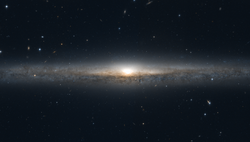Astronomy:NGC 5170
| NGC 5170 | |
|---|---|
 NGC 5170 imaged by the Hubble Space Telescope | |
| Observation data (J2000 epoch) | |
| Constellation | Virgo |
| Right ascension | 13h 29m 48.769s[1] |
| Declination | −17° 57′ 59.39″[1] |
| Redshift | 0.005006[2] |
| Helio radial velocity | 1,502 km/s[3] |
| Galactocentric velocity | 1,386 km/s[3] |
| Distance | 83.5 Mly (25.59 Mpc)[3] |
| Apparent magnitude (V) | 12.4[2] |
| Apparent magnitude (B) | 12.07[3] |
| Absolute magnitude (V) | −21.6[4] |
| Characteristics | |
| Type | SA(s)c: sp[2] |
| Apparent size (V) | 9′.9 × 1′.2[2] |
| Other designations | |
| IRAS 13271-1742, NGC 5170, MCG-03-34-084, PGC 47394[3][5] | |
NGC 5170 is a large, nearby,[6] edge-on spiral galaxy in the equatorial constellation of Virgo. It was discovered on February 7, 1785 by William Herschel. This galaxy is located at a distance of 83.5 million light years and is receding at a heliocentric radial velocity of 1,502 km/s.[3] It is a member of the Virgo II Groups, a series of galaxies and galaxy clusters strung out from the southern edge of the Virgo Supercluster.[7]
The inclination of the galactic plane of NGC 5170 is tilted at an angle of ~86° to the line of sight from the Earth, which means the disk is significantly obscured. It is estimated to have a morphological class of type Sb to Sc, meaning the spiral arms are moderate to loosely wound. The bulge-to-disk ratio of 0.5 is more consistent with an Sb galaxy.[4] It has an estimated star formation rate of 1.37±0.23 M☉·yr−1, which is more than double the rate in the Milky Way.[4]
The galactic latitude of this star is 43°, making the field relatively free of stars in the Milky Way. Combined with the proximity and edge-on view of NGC 5170, this makes galaxy useful for studies of its globular cluster population. It is estimated to have a total of 600±100 globulars, which is much higher than for the Milky Way. A candidate ultra-compact dwarf galaxy has been identified that is associated with NGC 5170.[4]
Numerical modeling of this galaxy indicates it has a massive dark halo with a thin, low surface brightness disk.[6] The halo mass of NGC 5170 is 3.4×1012 M☉.[4] Examination of the galaxy with the Chandra X-ray Observatory showed there is no diffuse X-ray emission from hot gas in the extended galactic halo.[8]
References
- ↑ 1.0 1.1 Brown, A. G. A. (August 2018). "Gaia Data Release 2: Summary of the contents and survey properties". Astronomy & Astrophysics 616: A1. doi:10.1051/0004-6361/201833051. Bibcode: 2018A&A...616A...1G. Gaia DR2 record for this source at VizieR.
- ↑ 2.0 2.1 2.2 2.3 "NASA/IPAC Extragalactic Database". Results for NGC 5170. http://nedwww.ipac.caltech.edu/cgi-bin/nph-objsearch?objname=NGC+5170&img_stamp=yes&extend=no.
- ↑ 3.0 3.1 3.2 3.3 3.4 3.5 Tully, R. Brent et al. (2016). "Cosmicflows-3". The Astronomical Journal 152 (2): 21. doi:10.3847/0004-6256/152/2/50. 50. Bibcode: 2016AJ....152...50T.
- ↑ 4.0 4.1 4.2 4.3 4.4 Forbes, Duncan A. et al. (March 2010). "A blue tilt in the globular cluster system of the Milky Way-like galaxy NGC 5170". Monthly Notices of the Royal Astronomical Society 403 (1): 429–438. doi:10.1111/j.1365-2966.2009.16130.x. Bibcode: 2010MNRAS.403..429F.
- ↑ "NGC 5170". SIMBAD. Centre de données astronomiques de Strasbourg. http://simbad.u-strasbg.fr/simbad/sim-basic?Ident=NGC+5170.
- ↑ 6.0 6.1 Khoperskov, A. et al. (July 2010). "Numerical modelling of the vertical structure and dark halo parameters in disc galaxies". Astronomische Nachrichten 331 (7): 731. doi:10.1002/asna.200911402. Bibcode: 2010AN....331..731K.
- ↑ "The Virgo III Groups". Atlas of the Universe. http://www.atlasoftheuniverse.com/galgrps/viriii.html.
- ↑ Pedersen, Kristian et al. (May 2006). "Discovery of a very extended X-ray halo around a quiescent spiral galaxy The "missing link" of galaxy formation". New Astronomy 11 (7): 465–470. doi:10.1016/j.newast.2005.11.004. Bibcode: 2006NewA...11..465P.
External links
- NGC 5170 on WikiSky: DSS2, SDSS, GALEX, IRAS, Hydrogen α, X-Ray, Astrophoto, Sky Map, Articles and images
Coordinates: ![]() 13h 29m 48.8s, −17° 57′ 59″
13h 29m 48.8s, −17° 57′ 59″
 |

